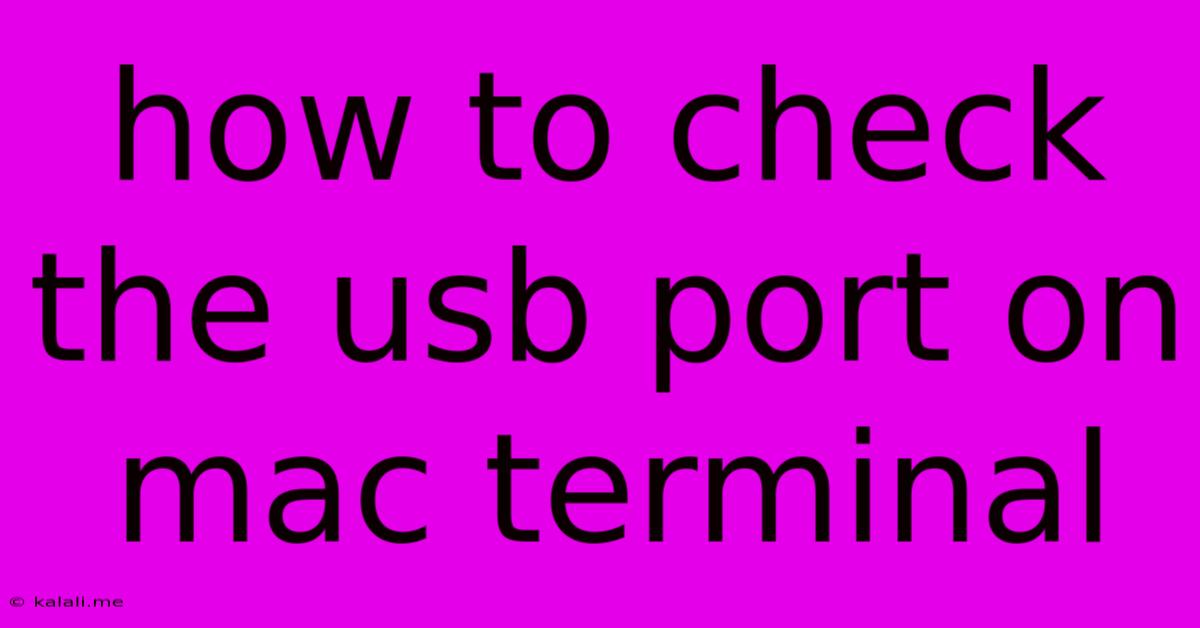How To Check The Usb Port On Mac Terminal
Kalali
Jun 06, 2025 · 3 min read

Table of Contents
How to Check Your USB Ports on Mac Terminal: A Comprehensive Guide
Knowing the status of your USB ports can be crucial for troubleshooting connectivity issues on your Mac. While you can visually inspect the ports, a more in-depth analysis can be performed using the Terminal app. This guide provides a comprehensive walkthrough of different commands to check your USB ports on your Mac's terminal, ensuring you can quickly identify and resolve any problems. This includes checking for connected devices, identifying port issues, and understanding the underlying system information.
Why Use the Terminal?
The Terminal offers a powerful way to interact directly with your Mac's operating system. Compared to visual inspection, using the Terminal provides more detailed information about your USB ports, including details that aren't readily apparent through the graphical user interface. This detailed information is invaluable for diagnosing complex connectivity problems.
Methods to Check USB Ports in Mac Terminal
We'll explore several commands, each providing slightly different information about your USB ports.
1. Using system_profiler
This is a versatile command that provides a wealth of system information, including details about your USB devices. This is a great starting point for a general overview.
system_profiler SPUSBDataType
This command will output a detailed list of all connected USB devices, including their vendor ID, product ID, serial number, and other relevant information. This is particularly useful for identifying specific devices and troubleshooting connection problems. You can further refine this command by specifying a particular device if you already suspect a problem with a specific USB item.
2. Using lsusb
lsusb is a powerful command-line tool for interacting with USB devices. It offers a concise yet informative overview of your USB hardware.
lsusb
This command provides a list of connected USB devices, displaying their bus number, device number, and vendor and product IDs. This information can be extremely useful for identifying devices and comparing them against online databases for further identification if you encounter unknown devices.
3. Checking the System Log (log command)
If you're experiencing intermittent connectivity issues, checking the system log might reveal errors related to your USB ports.
log show --predicate "subsystem == 'com.apple.iokit.usb'" --last 1h
This command displays log entries related to the USB subsystem within the last hour. Adjust the --last parameter (e.g., 1d for the last day, 7d for the last week) to widen or narrow the search timeframe depending on the nature of your issue. This can help pinpoint recent problems that might not be immediately apparent through other commands.
4. Understanding the Output: Key Information to Look For
Regardless of the command you use, pay close attention to the following information in the output:
- Vendor ID and Product ID: These identifiers uniquely identify the USB device. If you are having problems, searching for these online can help you find information about the device and potential compatibility issues.
- Serial Number: This helps to distinguish between multiple devices of the same type.
- Errors or Warnings: The system logs might contain error messages that indicate problems with your USB ports or connected devices.
Troubleshooting Common Issues:
- Device Not Recognized: If a device isn't recognized, check the output of
lsusbandsystem_profilerto see if it appears. If not, try a different USB port or cable. - Intermittent Connectivity: Check the system logs for errors related to USB ports and devices.
- Port Malfunction: If a specific port consistently fails, try a different port. If the problem persists, you may have a hardware issue requiring professional assistance.
By using these Terminal commands and carefully analyzing the output, you can effectively diagnose and resolve many issues related to your Mac's USB ports. Remember to always back up your important data before attempting any hardware troubleshooting.
Latest Posts
Latest Posts
-
How Do I Wire A 3 Way Dimmer Switch
Jun 06, 2025
-
How To Recycle Plastics At Home
Jun 06, 2025
-
How To Get Rid Of Dirt Dauber Nest
Jun 06, 2025
-
What Happens If You Dont Grease Brake Pads
Jun 06, 2025
-
Set You Up To Get In Trouble
Jun 06, 2025
Related Post
Thank you for visiting our website which covers about How To Check The Usb Port On Mac Terminal . We hope the information provided has been useful to you. Feel free to contact us if you have any questions or need further assistance. See you next time and don't miss to bookmark.